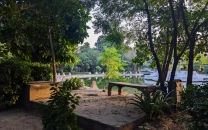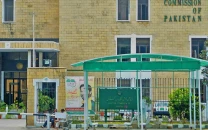Mobility in an unequal city
The lack of willingness to identify mobility challenges hamper the availability of mobility solutions in Karachi

Innovation in mobility is proceeding at a fast pace. However, urban centres are facing an array of
challenges in its wake, such as ageing populations, urbanisation and pollution. The scenario is
more complex in the Global South as mobility is not limited to the above factors alone, it is also
tied up with governance patterns, gender, availability of modes, affordability, infrastructure,
climate change, sustainability, and decision-making in support of mobility. In developing
nations, automation and electric propulsion are disrupting technologies in connection to micro-
mobility in terms of sustainability and expense of installation to operation and maintenance.
In Karachi, we encounter numerous obstacles such as inadequate infrastructure, absence of
public transportation, poorly planned routes, gender-related mobility issues, high population
densities, an ageing population and individuals with varying abilities, unprotected open drains,
road imperfections, traffic congestion, frequent accidents, limited affordability, and the influence
of sociocultural norms. Why can’t we follow the principles of responsible upgradation and
innovation? Why not try for a renewed mobility which provides access to all across the city?
The lack of institutional and political willingness to identify mobility challenges hamper the
availability of affordable and feasible mobility solutions in the metropolis.
Cities need to change their priorities
Pakistan’s most populous city needs to change. With the highest congestion rates in Pakistan
compounded with problems of pollution, Karachi is constantly evolving, but the city’s
administration fails to update the infrastructure and services, including public transportation
which was quite good and adequate in the past.
The problem with our policymakers is that they think building more expansive and improved
highways helps to manage urban transportation issues. In contrast, the tenets of sustainable
transportation promote the use of affordable public transportation that might function effectively
in cities like Karachi with large densities and diversified land use. Globally, public transportation
is a useful tool for tackling a variety of societal issues, including mobility, sustainability, and
liveability.
Public buses vs BRT projects
Karachi, home to 25-30 million, is not evenly spread but follows the urban/rural divide
characterising many of the prevalent socio-economic phenomena. A mobility project with
automation and artificial intelligence requires a large sum of money (for instance the BRT
project). It is very expensive and not affordable for the urban poor. While it can be installed, it would be a burden for a developing country like Pakistan. Additionally, it would require ongoing
financial support and pose a challenge in managing its advanced technology and maintenance
needs. Furthermore, the project only covers a single route, serving a small portion (five to seven
percent) of the city's population.
Four different projects of mobility (for instance, public transport bus routes) can be started with
the same finance without automation, not subsidised. Operation and maintenance can be done
locally and can cover four different routes to serve 20 percent of the city’s population.
Ultimately, encouraging shifts toward public transportation could be made possible through
integrated public transport planning which combines different modes of transport to maximise
ease and efficiency.
Mobility options in Karachi’s planning - Present and Past
Karachiites have to leave their homes or places of employment hours in advance, yet they still
arrive late due to clogged traffic on roads. This results in time loss, extreme exhaustion from
constant travel, and carbon pollution from exhaust fumes. Heavy traffic bottlenecks will
undoubtedly occur when there are 30 cars on the road instead of one bus. We can look at
Singapore as an example to emulate in order to overcome this predicament. The Singaporean
government discourages personal vehicles and encourages public transportation. In Singapore,
53 percent of the populace has been persuaded to use public transportation.
Outdated infrastructure exacerbates Karachi's traffic problems. In some areas in the city where
underpasses, flyovers, and at-grade roads are present, congestion is still common throughout the
day, not just during rush hour. Examples are the Nazimabad stops or the Liaquatabad 10 number
stop.
Commuting is a daily hardship for the citizens of Karachi whether they live in the city centre or
its periphery. The first challenge is affordability. The main issue is Karachi's ongoing inability to
create and manage its public transportation networks in a way that offers a high level of mobility,
equity, and environmental sustainability. Additionally, carbon emissions in urban areas can be
greatly reduced by using public transportation, walking, and cycling. Several aspects, like the
significance of governance, capacity building and urban planning, must be considered in addition
to climate change to provide effective public transportation in Karachi.
In the past, we had several examples of urban mobility: buses run by the Karachi Transport
Corporation, the Karachi Circular Railway, and tramways. As the city expanded, and densified,
we failed to adapt those services to the changing dynamics of the city. Now urban mobility is a
monstrous challenge for a large segment of society. As city planners, we are often asked for
solutions.
While we can suggest people-centred approaches based on urban mobility planning,
the approval and implementation of these ideas are beyond our control. Political motivation is
required to benefit everyday citizens and provide them with affordable services that adapt to the
changing dynamics of the city.
Mobility with safety – Gendered lens
Mobility is the lifeblood of civilisations as it spurs economic activity and shapes societies. Cities
depend on robust transportation systems for their growth and sustenance. The gradual
resumption of economic activity in Karachi has been accompanied by demands to normalise
Karachi’s public transport system. Karachi Urban Lab’s last project Land, Governance and
Gendered Politics of Displacement in Urban Pakistan recorded harrowing narratives of people
commuting from Lyari Basti, Taiser Town to the city centre for over four hours a day, by
changing three vehicles which are also beyond their affordability. Additionally, working women
are unable to make such arrangements. With the building of Lyari Expressway, people who were
living in Karachi's district central were forcefully displaced and resettled in Karachi's periphery,
21 km away from their previous homes. The city’s administration has failed to provide
affordable public transport to them.
Another issue is the safety of commuters. We do not have specific guidelines for the safety of
rules to be followed in all modes of transport. Mobility for females has a variety of challenges;
no safety at bus stops, and limited seating capacity as they wait for 30 minutes for a bus. Socio-
cultural barriers also exist, as women cannot select the bike services available in the city for
affordable commuting. Also, carpooling is impossible within this framework. Some of my
students at Karachi University told me that to reach the Urban Resource Center, located at
Baloch Colony, they gather at Nipa Chowrangi and share a ride-hailing cab to commute.
Although, riding a motorcycle is a good option for them but not acceptable in our society.
Karachi’s Public Transport system is the worst globally
A study by car-parts company Mister Auto that looked at 100 major cities in 2019, published in
Bloomberg, ranked Karachi as having the worst public transport system globally. Bogota was the
second-worst city, while it has an Integrated Public Transport System including BRT, Bus, and
Gondola lift services. Although, in 2000 Bogotá introduced the first BRT system to combine the
best elements of a BRT and achieved the highest capacity and highest speed BRT system in the
world, in terms of the public transport system, Bogota is the second worst globally. Policy
designers and decision makers must take note of this example that having a BRT system (not
comparing the quality of service here) does not mean having the best public transport system.
We can also see this in New York, Singapore, Tokyo, and London.
Under the Karachi Mobility Project, in 2019, the World Bank submitted an Environmental
Impact Assessment report to the Sindh Mass Transit Authority. The report revealed that, “There
were over 12,000 public transport vehicles (including buses, minibuses, and coaches) serving
267 routes in the city owned by private transporters. However, the number of buses has
decreased steadily and reached less than 5,000 in 2017, serving only about 100 routes.
City officials in Karachi make grand promises about the future of public transport, but
unfortunately, these promises go unfulfilled. They claim that a few buses, like the People's bus service, will be enough to meet the needs of the 25 million residents.
This seems like nothing more than a dream, as the reality of the situation suggests otherwise.
Integrated Public Transport Scenario in Karachi
The map showing the routes of the New Red Bus in Karachi (called Peoples Bus Service) is very
impressive and gives a sense that we are connected by a public transport system. However, in
reality, this cannot be further from truth. For a city of 25 million, a total of 250 buses will operate
on 14 routes in Karachi, which include eight routes of red buses, three routes of electric buses and
three routes of pink buses. Keep in mind that these Red Buses have a seating capacity of around
40 people with dedicated spaces for ladies, along with standing capacity of around 40 more
persons. If we add, the Green Line BRT’s 80 buses – with a seating capacity of 40 seats, Orange Line
BRT’s 20 buses with a seating capacity of 31 each.
Now we must look at what Karachi demands. According to the World Bank, there needs to be
one bus with 100 seats for every 1,500 population, keeping in line with the internationally
accepted ratio.
However, considerably fewer government buses, a total of 350 – max 40-seaters – are currently
running on the roads of Karachi.
According to the World Bank report, a rapid decline can be seen in public transport during the
last decade due to insufficient investment in the sector or shifting of investment from transport to
real estate, which is a 100 times more profitable business in the city. Despite an increase in the
price of fuel, this has led to a shift in demand from public transportation towards other modes of
transportation, such as motorcycles, private cars, and informal Qingqi rickshaws.
As of mid 2018, there were 4.6 million registered vehicles in Karachi — mainly motorcycles and
cars, which increased up to 6.8 million in mid 2022 (only up-to 800 cc vehicles and motorcycles
included) — where motorcycles account for 86 percent of the total registered vehicles. On the
other hand, public transport (para transport not included) accounts for only 0.5 percent of the
total registered vehicles. While the growth rates for motorcycles was 120 percent, between 2011
and 2018 are now over 200 percent in the last 10 years. Now 1,000 new vehicles have been
added to the streets of the city each day.
We are not prioritising eco friendly options
Cities across the world have given cycling and walking a boost as popular ways of
transportation. 90 cities were ranked by the Global Bicycle Index 2022 to see which ones are the
most bicycle friendly. The index gave the cities points based on the proportion of cyclists, crime
and safety, infrastructure, the outside temperature, the availability of bike sharing, and cycling-
related activities.
The highest number of "cyclable" days and high-quality bicycle infrastructure,
such as bike lanes, can be found in European cities, which also have the most bike-friendly
environments overall. The bicycle-friendliest city in the world is Utrecht, Netherlands. The
indicator indicates that roughly 51% of people in the city are using bicycles. The German city of
Münster comes in second on the list.
In Pakistan, we don’t have a track for cycling. The first one is in planning in Islamabad, but what
about other cities? It is not our priority to support non-carbon-emitting commute options.
Bicycles should be the vehicle of choice for a great majority of Karachi’s residents. It seems like
the perfect option for a metropolis like Karachi which struggles with a decent public transport
system. Most of its population is young or people engaged in the informal economy, working
class and cannot afford to independently own or sustain a motor vehicle, but need to constantly
navigate the sprawling megacity for work or education. Yet, unlike most urban metropolises
around the world, bicycling remains a rather unpopular mode of transport here. In fact, cycling is
often perceived as an activity for the well-off, who view it as a fitness endeavour or a weekend
hobby.
A lesson from the world
Let us look at the underlying paradoxes in Karachi's transport landscape and the possible way
forward.
For the best public transport system, we need to focus on some factors including routes, distance
to public transit, affordability in terms of low fares, operating hours, crowding and commute
speeds and number of buses, limited delays or service disruptions, and a financial model to
support itself.
People need the accessibility, reliability, and affordability of the public transportation system in a
metropolitan area. Their choice is not specific to a BRT or MRT. They first need a bus transit
system and once we have that, the next step would be to move towards an integrated public
transport system with BRT and MRT (if we can afford to bear the installation and operational
cost).
The reality is that Karachi lacks reliable public transit, forcing everyone to drive their own
vehicles. This problem is not unique to Karachi, as many large and expanding metropolitan areas
across the world, including Los Angeles, Tokyo, Cairo, and Sao Paolo, are facing increasing
traffic congestion. To plan a public transport system in Karachi, first we need current data on
demand and supply, which includes the ratio of the dedicated public transport infrastructure (Bus
Transit, and BRT,) per capita and per overall road length, as well as data on the share of
residents who want to use public transportation to commute. Better planning, and more focus on
accessibility and ease of public transport can contribute to the fall in density of road traffic.
Muhammad Toheed is an urban planner and geographer. He is Associate Director at
Karachi Urban Lab, IBA
All facts and information are the sole responsibility of the author



















COMMENTS
Comments are moderated and generally will be posted if they are on-topic and not abusive.
For more information, please see our Comments FAQ